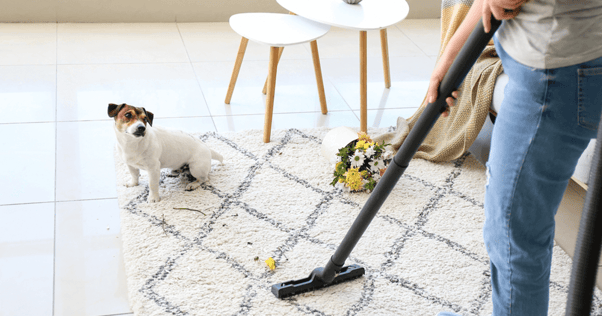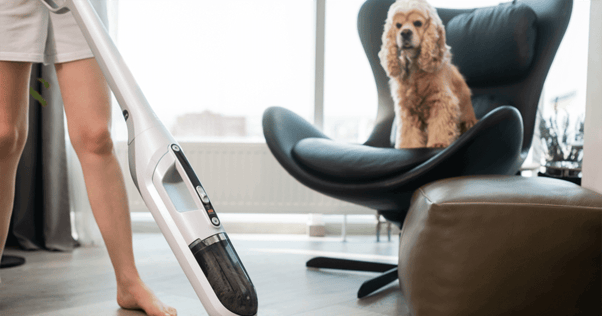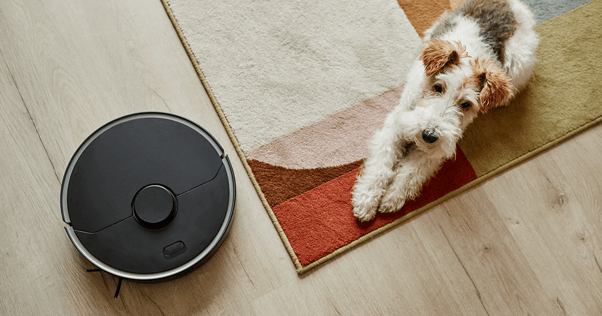Why Some Dogs Are Scared Of Vacuums When Others Are Not
Vacuuming is a normal household chore that we all face day to day. But for some of our four-legged friends, it can pose as more of a problematic situation. More than often, dogs are afraid of vacuums which makes the task of cleaning around the house that little more complicated.
We can’t avoid the task all together, so how can we work our way around this if our dog is scared of vacuums? We’re here to help offer advice so that you can work with your dog to create positive associations with the vacuum cleaner. And hopefully, the end result should mean you can clean without worrying about your dog getting upset.
What objects are dogs afraid of?
Household objects that dogs tend to be afraid of include vacuum cleaners, brooms and lawnmowers. With these all being common household objects, it’s important to address the cause of their fear.
All dogs are different. Therefore, not each case or extent of their fear of objects will be the same. Some dogs are sensitive to everyday noises, whereas others remain calmer. Likewise, for some dogs that have been conditioned from a young age, vacuums are simply just an encounter. For others however, it can be more challenging and cause them distress.
Vacuum cleaners from a pooch's point of view

When you think about it, a vacuum cleaner is an odd object for dogs to get used to. The same applies for lawnmowers. Let’s put ourselves in their shoes. It makes a lot of noise, is quite big, shudders and vibrates! So, imagine this large unknown object is making loud noises and coming towards you. To a dog, it can seem as if they are being chased.
Then we also have the robotic form of vacuums. These may be seen as even more unpredictable! Not only do they make noises when starting up, but they also move rather suddenly and then hide away. From a dog's angle, they would seem to behave like another small creature. And this all makes perfect sense with why some dogs are afraid of vacuums.
Despite there being other loud household objects, such as a hairdryer, these don’t make anywhere near the same level of noise and disruption. Without gentle and gradual introduction to “mysterious” objects, your dog can become scared of these overtime.
Signs your dog is scared of the vacuum cleaner
- Hiding
- Drooling
- Pacing around
- Barking
- Attacking the hoover when you are using it
These are all possible signs that your dog is scared of vacuum cleaners.
Why are some dogs afraid of vacuums?
The reasons for why some dogs are scared of vacuum cleaners will differ, but the main reasons include:
Sound Sensitivity
The most common reason why dogs are afraid of vacuums is the noise they give off. Dogs have amazing hearing and can hear different frequencies to humans. This means a normal sound to us may sound far more distressing to our four-legged friends. We also have to keep in mind that some dogs have noise anxiety. This can make them even more sensitive to loud, sudden noises.
Although we tend to think of loud bangs like fireworks when thinking of noise anxiety in dogs, it’s important not to discount the generic household object. In fact, hoovers are a more than typical sound that scares dogs.
Feeling Under Attack
It is possible that your dog sees the vacuum cleaner as a threat. With the loud and scary noises they can produce, a dog could feel scared of this and jump into protector mode.
Nervousness
In general, nervous dogs may find the noise and presence of a vacuum cleaner overwhelming. Because of this, their response tends to present itself in signs of fear.
Sense of Smell
Their sense of smell works the same way as their heightened levels of hearing. Dogs have a powerful sense of smell so it could very well be that the vacuum is releasing different scents to what they are used to. As they pass over the floor lifting dirt and debris, the smell they give off can contribute to a sensory overload for your dog.
A Bad First Encounter
A situation as small as a bad first encounter could very well be the reason why your dog is scared of vacuums. As with other fears, these can develop and worsen over time. Bad experiences could involve being startled by the vacuum or accidentally having a paw get in the way, which could result in them viewing the object as a concern in the future.
How to help your dog overcome their fear
The key to helping your dog overcome their fear is gradual exposure. This involves increasing exposure step-by-step, at a pace your dog is comfortable with, while rewarding them as you go to reinforce this calm approach.
It will take time to help them learn that vacuum cleaners are just another household item. For nervous dogs, it could take a little longer to make the adjustment.

- Praise your dog during each session or reward them with treats! Positive reinforcement will help them to develop positive feelings. It’s important to never punish your dog for reacting negatively as this will only reinforce their fear.
- Whether you are introducing it as a new object or reintroducing the scary suspect, make sure your dog is feeling calm. Enter and re enter the room when the vacuum cleaner is out. Repeating this multiple times and rewarding your dog for remaining calm will help them to see that it’s nothing to be scared of.
- The next step is to help your dog get closer to the vacuum cleaner when it is turned off. Over time, increase the amount of movement from the vacuum and how close it gets to your dog. Our top tip is to always keep an eye on your dog’s body language! Do they seem calm and relaxed? Or are there signs that could indicate your dog is afraid of the vacuum?
- If you notice your dog lunging for the vacuum cleaner, keep moving it slowly but be careful not to stop the movement straight away. By stopping, you can unintentionally teach your dog that attacking the vacuum stops it. Instead, try to distract your dog away from the vacuum before stopping. If you move the vacuum too close and too soon, this could cause your dog to lunge for it.
- Once your dog seems comfortable with the movement when switched off, you can start to introduce the sound. You can start by turning it on in another room for a period of time. Whilst the sound is playing in another room, reward them with treats for remaining calm. Continue with this level of exposure until your dog doesn’t react to the noise anymore.
- Lastly, the sound and movement of the vacuum cleaner need to be combined. Try a slow and steady mixture of the movements and noise, both near and far away from your dog. Test the waters slowly to see how they react and once they seem comfortable, move closer to your dog.
As well as these tips, you may also want to consider products that could help your nervous dog with loud indoor noises. The ADAPTIL Calm Diffuser can be used in conjunction with the above advice to give your dog the best chance of overcoming their fears.
Note: If the above tips do not work and your dog shows severe anxiety, or their ability to cope is getting worse, always consult your vet to check for any underlying conditions. We also recommend getting advice from an accredited behaviourist or trainer.
It’s important to always maintain patience with our four-legged friends! If trying these steps progressively, overtime you should start to see results. Taking things step by step should help break the cycle of fear for dogs scared of vacuums. And for those who are new to the object, following these steps will help condition them from the get go.
For more tips and advice on keeping your dog calm in stressful situations, contact us. We offer a collection of products for supporting dogs and cats. Check out our customer testimonials to hear more on what they thought!

Related posts
Leave A Comment
Want to sign up for our blog?
Information Notice
The personal information collected is intended for Ceva Santé Animale, and Ceva group companies, in order to manage your request.This information may be passed on to service providers in order to organize this management. In accordance with the Regulations on personal data you have rights of access, rectification and limitation of processing of your data. You may also, in certain limited cases, oppose the treatment, withdraw your consent and request the deletion and portability of your data. For any request relating to your personal data please go to this page